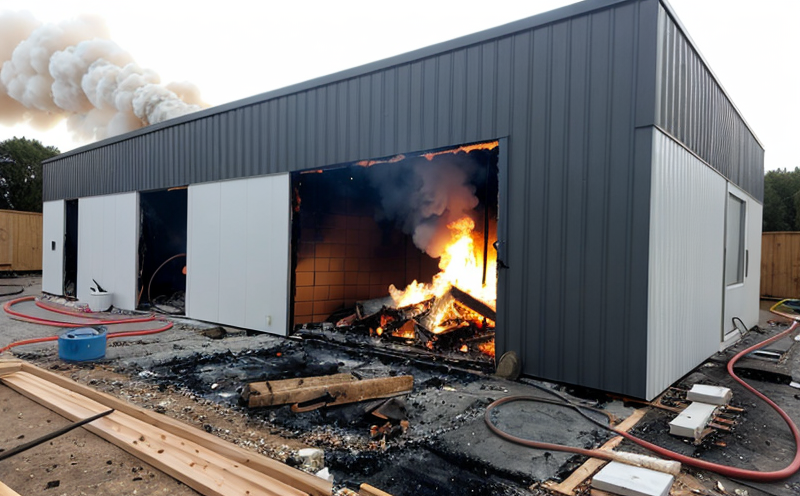Fire Load Assessment of Cladding Systems
The fire load assessment of cladding systems is a critical component in ensuring compliance with international standards and enhancing building safety. This service evaluates the combustibility of cladding materials, which can significantly impact the risk of fire spread during emergencies. The process involves assessing the amount of fuel available within the cladding system that could contribute to fire growth and propagation.
The importance of this assessment cannot be overstated in today's urban environments where tall buildings are common. Insulation and cladding systems form a significant part of the external envelope of many high-rise structures, and any fire incident involving these materials can have catastrophic consequences. By performing comprehensive fire load assessments, we provide stakeholders with valuable insights into potential risks and help implement measures to mitigate them.
The assessment typically involves several stages. Initially, the cladding system is dissected to identify all combustible components. This includes not only the insulation layers but also any adhesives or sealants used in assembly. Once identified, these materials are weighed using precise scales, ensuring accuracy down to milligram levels.
The next step involves determining the energy density of each combustible component. This is achieved by measuring the calorific value of the material when subjected to controlled combustion tests according to international standards such as ISO 5267-1 and ASTM E1354. The calorific value provides a measure of how much heat can be released during burning, which is crucial for understanding the potential fire load.
Additionally, we consider environmental factors that could influence the fire behavior of cladding systems. This includes ambient temperature, humidity levels, wind speeds, and proximity to other buildings or structures. These external conditions can significantly affect how a fire might spread within or between buildings. Our comprehensive approach ensures that all relevant variables are accounted for in our assessments.
Following these detailed evaluations, we compile the results into clear, actionable reports tailored specifically for your needs. These reports serve as essential tools for architects, builders, and regulatory authorities, guiding them towards more informed decision-making processes regarding fire safety improvements.
Our expertise lies not only in conducting rigorous tests but also in translating technical findings into practical recommendations. Whether you are looking to enhance existing structures or design new ones from scratch, our fire load assessment services offer valuable support throughout every stage of the project lifecycle.
Applied Standards
In performing fire load assessments on cladding systems, we adhere strictly to internationally recognized standards that ensure accuracy and reliability. For instance, ISO 5267-1 provides guidelines for testing the calorific value of combustible materials under controlled conditions. Similarly, ASTM E1354 outlines procedures for measuring heat release rates during combustion.
These standards are integral to our methodology because they provide a consistent framework against which all test results can be compared. By following these protocols, we ensure that our findings are both accurate and comparable across different projects and locations worldwide. This consistency is particularly important given the global nature of many construction projects today.
Besides these primary standards, we also integrate other relevant guidelines such as EN 13823 for specifying fire performance requirements for building materials and products. These additional references help us tailor our assessments more precisely to specific local or regional regulations while maintaining international best practices.
Why Choose This Test
Selecting the right fire load assessment service is crucial when it comes to protecting your investment in cladding systems and ensuring compliance with strict safety regulations. Here’s why choosing our specialized testing can benefit you:
- Provides accurate data on combustible materials.We use state-of-the-art equipment and methodologies to measure the calorific values of all components within your cladding system, ensuring precise quantification.
- Ensures regulatory compliance.Our assessments are conducted in accordance with ISO 5267-1, ASTM E1354, and other relevant international standards, providing you with the assurance needed to meet local and national fire safety codes.
- Offers practical recommendations for improvement.Beyond mere testing, we offer actionable insights based on our findings. These can help prevent future issues or improve current design elements.
- Enhances overall building safety.By identifying potential fire hazards early in the process, you can take proactive steps to reduce risks and protect both your assets and occupants.
Choosing us means investing in a safer environment while also safeguarding against costly penalties associated with non-compliance. Our commitment to excellence ensures that every project receives the highest quality service possible.
Customer Impact and Satisfaction
Our focus on delivering high-quality fire load assessments has led to numerous positive outcomes for our clients across various sectors. By providing reliable data about combustible materials in cladding systems, we enable better decision-making processes that prioritize safety without compromising functionality or aesthetics.
Many of our customers have reported increased confidence in their products and projects after receiving our reports. These documents not only demonstrate compliance with relevant standards but also serve as valuable tools for ongoing improvements. They facilitate smoother interactions with regulatory bodies and enhance credibility among stakeholders.
We strive to maintain a level of service that exceeds expectations, fostering long-term partnerships based on trust and mutual respect. Our dedicated team works closely with each client throughout the entire process, ensuring clear communication and support every step of the way. This personalized approach contributes significantly to our clients' overall satisfaction levels.





